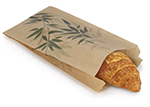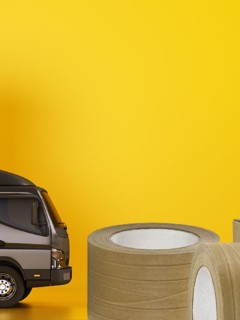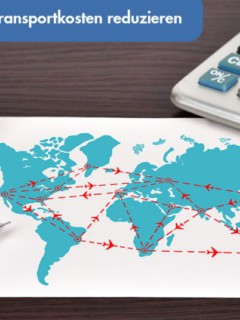Sustainability and shipping optimisation in packaging continues to be a trend. Even with packaging innovations, manufacturers are increasingly turning to sustainable alternatives to conventional shipping options. These are often lighter, more practical to handle and save on shipping costs. Win Win Win? Fabian Kraft, Head of Purchase, is always on the lookout for innovative packaging. We have picked out a few for you. But what is behind them? And does sustainable really mean sustainable?
Innovative packaging 1: Mobile wet tape dispenser
Adhesive tape – but wet? Maybe you already know the principle, but maybe you’ll wonder why we think it’s good to make adhesive tape wet. There is a simple, yet ingenious reason for this: wet adhesive tapes are made of paper and are coated with a plant-based, starchy adhesive that only develops its adhesive effect when it is made wet. Then, however, the bond between the cardboard and the adhesive tape is so strong that it can no longer be removed without leaving visible traces. Bonus: The ideal theft protection.
Wet tape is first unrolled to the appropriate length, moistened and then cut from the roll before being applied to the box. To do all this by hand would be very cumbersome. But it is not necessary at all, because special semi-automatic or fully automatic wet tape dispensers deliver moistened tape in the desired length at the touch of a button and within seconds. But these machines are quite heavy with their water tanks and are usually stationary in the packing room. The package and its contents have to be transported to the machine. Depending on how your packing station is set up, this can disrupt the packing rhythm or put additional strain on the packers.
So the important question is: What if the wet tape could be used where it is needed? Or even more precisely: what if the wet tape could be carried to the parcel instead?
The innovative packaging solution is called: Mobile wet tape dispens
er
.Mobile wet tape dispensers work in much the same way as their big brothers and sisters, only they are designed for – you guessed it – mobile use. Similar to dispensers for conventional adhesive tapes, the innovative, mobile wet tape dispensers can simply be used at the desired location. This is made possible by an integrated, handy water tank in the portable device, which you fill up as needed. Another bonus here is the price: the innovative wet tape dispensers for carrying are cheaper to buy than their larger (admittedly more powerful) siblings. Thus, the mobile dispensers are a suitable “starter drug” for sustainable wet adhesive tape that even “smaller” mail order companies can afford.
How sustainable is wet adhesive tape?
Conventional plastic tape is often thrown into the same waste as the box. But that’s not where it belongs. Because plastic tape, especially if it is coated with crude oil-based glue, cannot always be recycled and does not belong in paper recycling. The right thing to do here would be to remove the tape as completely as possible from the cardboard and dispose of it separately. However, if you have ever tried this, you will have noticed that it is difficult to do.
Wet tape is an innovation in itself: since it is paper-based and the adhesive is 100% biodegradable, it can be recycled along with the cardboard without a guilty conscience. And the hand dispenser? Thanks to its robust quality, you can use it for a long time. However, if it should become obsolete, it can be disposed of like other electronic devices.
Innovative packaging 2: Pressed wood pallets made of binder wood as an alternative to INKA pallets
Stack them high, but stack them right: pallets are an indispensable part of logistics. The best known is probably the Euro pallet – not least thanks to countless DIY furniture 🙂
But this has some disadvantages: it is heavy, requires a lot of space and is not always suitable for export. The reusable system is not always practical either – even if it does protect the environment.
Pressed wood pallets offer an innovative alternative. Similar to INKA pallets, they are lightweight, stackable, PEFC certified and suitable for export according to ISPM15. Although they weigh only half as much as a conventional wooden pallet, they have a load capacity of up to 1250 kg. So you save valuable weight during transport without sacrificing transport volume. Also practical: they can be stacked inside each other and take up significantly less space during transport and storage than classic Euro pallets or one-way pallets.
.How sustainable are pressed wood pallets?
Innovative pressed wood pallets consist, as the name suggests, of pressed wood fibres glued together with glue. The versions sold at RAJA are made of processed recycled wood and fresh residual wood as well as sawdust from sustainable forestry. This means that, unlike common one-way pallets and Euro pallets, no raw material is used. Due to their lower weight, less fuel is needed for transport, which saves furtherCO2 .
Innovative packaging 3: Lightweight transport boxes for the international shipment of heavy goods
.Shipping 3 tonnes of extra-long goods worldwide without a wooden box, and thus without an IPPC standard– and the whole thing stackable to save space. Sounds good, doesn’t it?
If stackable makes you think of the famous clamping bricks, you’re not entirely wrong. The system of MC-Liner boxes made of corrugated cardboard and honeycomb material works in a similar way. Thanks to a clever groove, these can be stacked on top of each other. Depending on the requirements and the weight of the goods, a pallet made of wood or cardboard or ESB boards with runners serve as a base. Items up to 6 metres long can be transported safely in the transport boxes with excess length.
Assembling the boxes made of cardboard is also much easier than with overseas boxes made of wood. The lightweight material can be assembled by a single person by simply plugging it together. The transport box can be stored disassembled and saves space.
Also practical:The IPPC regulations do not apply to transport means made of honeycomb cardboard and corrugated cardboard. This saves on documentation and protects the regional flora.
In addition, the large transport box for heavy goods made of cardboard is lighter than its wooden counterpart and ideally reduces transport costs and fuel.
.How sustainable is the transport box made of honeycomb cardboard?
If individual elements of the reusable transport box are damaged, they can be easily replaced. This saves resources. Less transport weight also means less CO2 emissions from the transport vehicle. The individual box does not make a big difference. But if large flows of goods are transported with lighter cardboard boxes instead of wooden boxes, this would mean a high savings potential of climate-damaging gases. A large Swedish furniture manufacturer, for example, has been optimising its packing dimensions and the shipping weight of its furniture for years – thus saving shipping costs and CO2. You can do the same! Cardboard boxes are also made from recycled material and can be easily recycled. Whereas wooden boxes that have been treated according to IPPC standards may not be recyclable. If they have not only been heat-treated but also treated with protective agents, they are sometimes a case for hazardous waste.
Innovative packaging 4: Moulded fibre parts for shipping liquids and complex products
.Egg, egg, egg who doesn’t know them – egg cartons that ensure eggs can be transported safely without breaking. The secret? Fibre that can be optimally adapted to the shape of the product to be transported – and thus protects it perfectly. Hardly anything can fall over, slip or break (egg cartons should nevertheless not be transported at the bottom of the shopping bag. 🙂
E-commerce mail order companies are also taking advantage of this: Fibre in the form of moulded fibre parts is optimally suited as packaging protection for all products that should not tip over during transport. Due to their rigid, optimally adapted shape, they offer even more stability for varnishes, paints and all other liquids than, for example, cushioning paper or bubble wrap.
But the sustainable packaging material fibre can do even more: the property of fibre to adapt to any shape during production makes moulded fibre parts increasingly popular even for complex product shapes or product sets. This makes them a good alternative to plastic moulds and Styrofoam, which are costly to produce and emit a lot of CO2. In addition, they are space-saving, stackable, economical and resistant. The high impact absorption makes them the optimal packaging for fragile goods. Dangerous goods can also be transported safely with moulded fibre parts as stabilisation.
What is moulded fibre made of? And: How is moulded fibre made?
Fibreboard is primarily made from waste paper and cardboard, which means that the manufacturing costs are lower than for conventional products such as Styrofoam.
The waste paper and cardboard are dissolved to pulp. With the help of a scoop frame and a suitable counter mould, the raw moulded part is created from the pulp. The still moist pulp is then dried.
Depending on the requirements, the raw mould can be refined with a moulding press and punch. Under the influence of heat, the moulded parts are stabilised and fixed in their fitting accuracy in a press. In this way, the moulded parts adapt optimally to the individual product shape. If desired, the resulting moulds can be embossed, finished and printed.
How sustainable are moulded fibre parts?
As already described, moulded fibre parts are made from waste paper. This means they are compostable and can be disposed of worldwide without special surcharges. After shipping, the moulded parts can be recycled together with the outer carton and thus remain as a raw material and part of the so-called circular economy. Who knows, maybe you will soon see your shipping carton again as an egg carton in the supermarket?
Innovative packaging 5: Glassine and kraft paper instead of plastic bags for fashion e-commerce
Another sustainable shipping trend 2023 is aimed primarily at the fashion industry, which has a large share in online shipping worldwide – and unfortunately produces a lot of waste as a result.
If you’ve ever ordered clothes online, like almost 70% of online shoppers in the EU, you’ll be familiar with this image: each item of clothing is individually wrapped in plastic bags that often tear when opened. So reusing them is out of the question. And they don’t really feel good in the hand either. What initially serves to protect the clothes becomes a nuisance at the latest when returning them (how is the garment supposed to get back into the torn open bag?) and when disposing of them. Moreover, not every plastic bag can be recycled without further ado.
What if there was a visually appealing and more sustainable solution for online fashion shipping?
Thesolution already exists: instead of plastic, the sustainable packaging for clothes is made of (recycled) kraft paper with a window made of glassine paper and cuts a good figure not only visually but also haptically. The structure of the kraft paper feels warm and goes well with the feel of clothes. The packaging also stands out visually in a high-quality way. It is also reusable, suitable for returns management and recyclable – a win-win situation especially for environmentally conscious mail order companies. But an online mail order company for fashion, clothing and home textiles that is gradually moving towards more sustainable clothing options (organic cotton, recycled content) should not stop at packaging either.
Shirts or underwear wrapped in sustainable packaging for fashion, for example, also stand out positively in the presentation of goods in retail or fashion stores.
If desired, the paper clothing packaging can also be printed in an environmentally conscious way.
RAJA is convinced and plans to add it to our range soon. Until then, you can already use our full glassine bag as a sustainable bag alternative.
What is the difference between parchment and glassine? And: How is parchment made?
Parchment, vellum and parchment paper are (semi-)transparent materials that are used, among other things, for writing. However, there are major differences in their production.
Theoriginal par chment is made from animal skin and is considered the precursor of paper. It has been used since antiquity and has since lost its importance.
Real parchment or also parchment paper is pulp paper that has been treated with chemicals (including sulphuric acid) and ground up. This makes it permanently greaseproof and wet-strengthened. However, it cannot be recycled. It must be disposed of in the residual waste.
For theinnovative online fashion packaging , the more environmentally friendly glassine is therefore used. It does not contain any toxic chemicals in the manufacturing process and is therefore 100% recyclable. For the noble, transparent look, the raw material cellulose is ground for a long time and then satinised (i.e. comprehensively smoothed).
A small disadvantage, but not relevant for online shipping: it is only splash-proof and not permanently wet-proof. Nevertheless, it reliably protects against dust and dirt and is free of bleaching agents and softeners that could damage sensitive materials in the long run. Glassine is therefore also used as a divider in photo albums or archives. Like its somewhat less noble but stronger relative parchment substitute paper, parchment is breathable, grease-repellent, food-safe and neutral in taste and odour, which is why it is also popular in the food industry. You know the less transparent version of parchment substitute paper as the sandwich bag from everyday life.
How sustainable is the substitute for plastic bags in e-commerce? Is parchment environmentally friendly?
A big advantage of this innovative packaging over plastic bags is that kraft paper and parchment are easy to recycle. Online shop customers can simply dispose of the material together with the cardboard in the waste paper. In addition, the kraft paper portion is also available made of 100% recycled paper. Plastic bags made of PE, for example, are also recyclable and can contain recycled content. However, the infrastructure for paper recycling is much better developed in Germany. Unfortunately, most plastic is incinerated, even if it is disposed of as recyclable material. Moreover, if plastic enters the environmental cycle through improper disposal, it remains there for centuries. Paper, on the other hand, becomes valuable compost. Whether paper or plastic – in the end, the following applies: recycled and recyclable material is preferable for packaging.
Conclusion
The ideal, sustainable solution does not exist. But many innovative minds are working to reduce the burden on the environment with their solutions. RAJA feels responsible for making its packaging range more and more sustainable. You will soon find some of the innovative packaging above in our range, others we already have in stock.
















